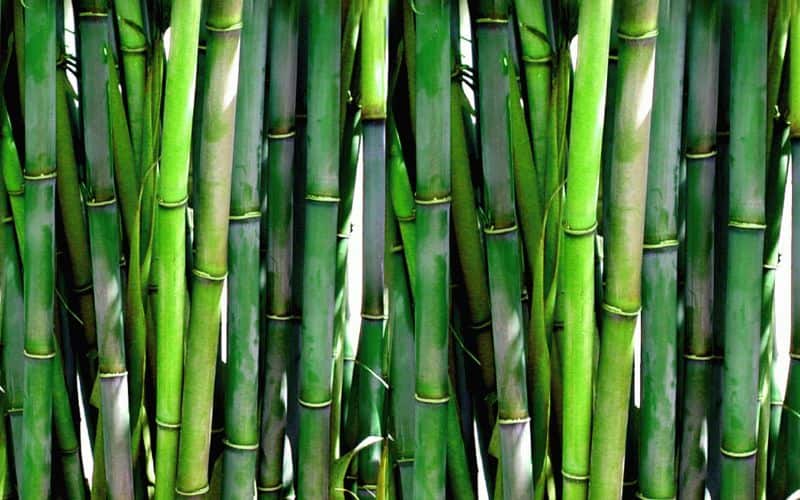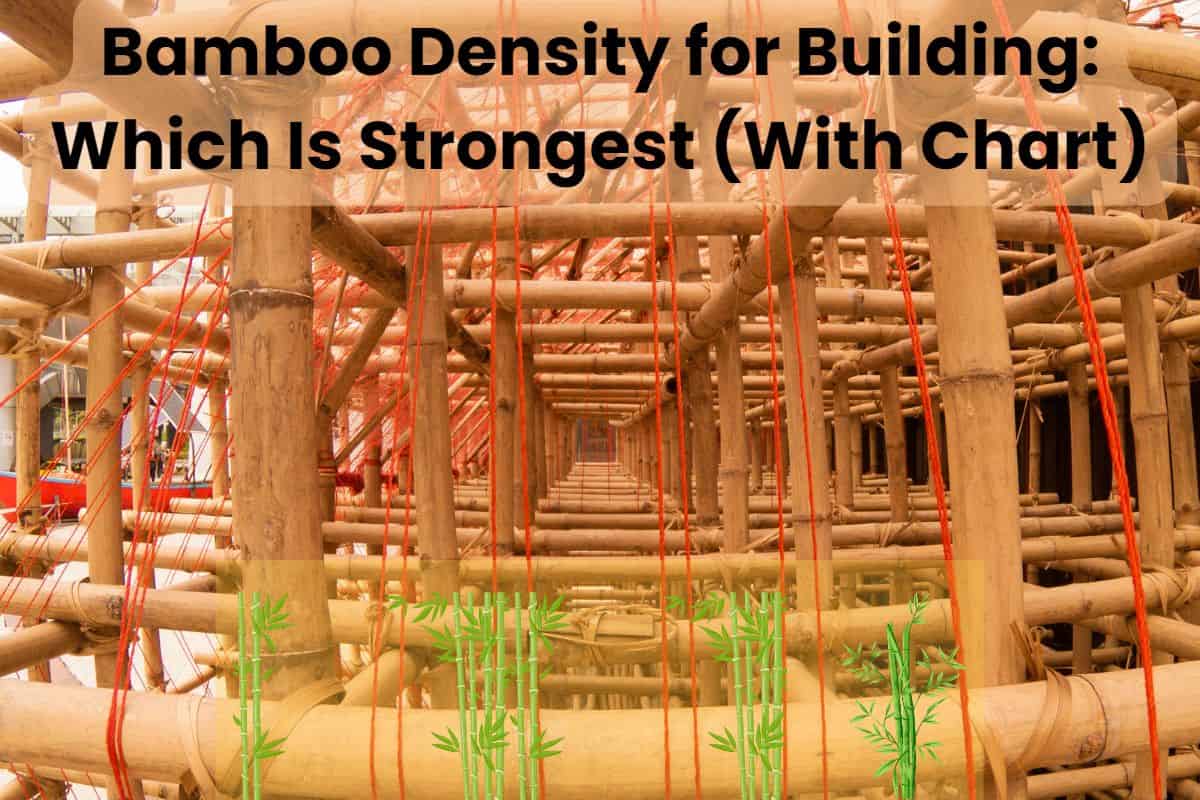What Is Sustainable Bamboo Construction? (Pros and Cons)

According to the World Economic Forum, the construction industry accounts for 38% of worldwide carbon emissions.
That’s quite the environmental impact and makes the construction industry one of the leading contributors to global warming.
As such, responsible builders are implementing sustainability measures to limit their carbon footprint and improve the other environmental aspects of their operations.
Sustainable bamboo construction is an eco-friendly alternative to other construction systems that leverages the renewable nature of bamboo to reduce the environmental impact of the construction industry.
In application, it provides energy and water efficiency, minimal waste, and lower emissions, potentially even resulting in a negative carbon footprint.
However, growing practices that result in the displacement of native plants and animals hamper the positive outcomes for sustainability.
In the following sections, we’ll take a closer look at bamboo as a sustainable material, including its advantages and disadvantages.
Read on to find out more!
Would you like to know how bamboo homes fare as an investment opportunity? If so, take a look at our article “Bamboo Houses As Investment Property (Can It Work?)“
Is Bamboo a Good Construction Material?

Bamboo has been used as a sustainable construction material since ancient times, especially in areas with an abundance of the bamboo plant.
These locations include Southeast and East Asian countries, parts of the United States, South America, Central America, and Australia.
This perennial evergreen, although used just like wood, is actually grass. Given suitable soil and climate, the bamboo plant can grow more than 100 cm in a single day.
That it them one of the fastest-growing plants in the world.
Bamboo is known to be resilient. It’s able to bend but not break. This ability makes it a good construction material. For a more comprehensive picture, here are some more bamboo properties that make it a good material to build houses with:
1. Compressive and Tensile Strength
The bamboo culm is hollow but reinforced with rigid cross-sectional partitions, giving it superior tensile strength to steel. This natural design is also responsible for its flexibility and elasticity.
Bamboo has high tensile strength because its fibers run in an axial direction. As such, it’s able to support more load without breaking.
It has a high compressive strength as well. So, it can bear weight while having good resistance toward size reduction.
These qualities make bamboo constructions earthquake-resistant and suitable for buildings in earthquake-prone locations.
2. Lightweight

Another good thing about bamboo is that it’s lightweight. This characteristic makes it easy to handle during transport and construction.
Plus, you can load more in one shipment compared to other alternatives. That lowers transport costs because you use less energy moving bamboo from one place to another.
3. High Flame Resistance
Bamboo has silica distributed in the plant leaves and culms. This impermeable layer provides water resistance and protects the inner fibers from insects and weather conditions.
It also gives the bamboo excellent fire resistance, enabling it to withstand temperatures up to 752°F (400°C).
Bamboo poses less of a fire risk than other building materials, such as timber, thanks to this amazing property.
4. Appearance

Bamboo poles have an attractive color, especially when stored and allowed to mature properly.
It has a smooth surface yet a hard texture. Little to no additional finishing is needed, as it’s already naturally appealing.
5. Workability
Bamboo is easy to work with due to the properties mentioned above. Plus, you can cut it quickly without the need for heavy machinery.
Better yet, it doesn’t pose any health risks during handling, unlike other construction materials.
Bamboo poles can be arranged not only vertically and horizontally but can be formed into arches as well. That allows many architects to incorporate bamboo into modern construction designs.
What Are the Advantages and Disadvantages of Bamboo Construction?

Bamboo is often used in structural frameworks in walls, partitions, posts, trusses, and beams in the construction industry.
Bamboo flooring is commonly used on modern construction sites, and bamboo construction materials can be found in ceilings, windows, and door frames.
Other uses include the building of footbridges and temporary structures. Bamboo can serve as support for concrete structures as well.
However, just like any material, it has advantages and disadvantages.
Advantages of Bamboo Construction
- Can be included in various designs
- Has a natural appeal
- Resilient and long-lasting when treated properly
- Low cost, especially in areas with an abundance of this natural material
- Can withstand hot and humid climates when constructed properly
- Ease of reconstruction when damaged
- Highly resistant to earthquakes
- Provides a natural cooling effect due to its insulating property
Disadvantages of Bamboo Construction
- Exterior surfaces and finishings need regular attention
- May require routine replacement of some portions
- Cannot withstand periods of heavy rainfall or snow
- Requires preservation to minimize decay, cracking, and pest as well as fungal attacks
- Needs reinforcement when it comes to securing joints
What Makes Bamboo Construction Sustainable?
Now that we know about the pros and cons of bamboo construction, let’s take a look at its sustainability.
Here are the reasons why it’s an eco-friendly building alternative:
1. Bamboo Is a Renewable Resource
Bamboo is a fast-growing, natural material and needs little maintenance. Typically, it matures between two to five years. In contrast, softwood needs about 25 years to grow fully.
Moreover, it has self-regenerating roots. If you harvest the bamboo culms, new shoots will grow even without transplanting. This keeps the soil intact, conserves it, and lessens soil erosion.
2. Reduces Carbon Dioxide in the Air
Bamboo plants positively impact air quality. As their numbers grow, they take up more carbon dioxide essential in photosynthesis.
A hectare of these plants can absorb as much as 12 tons of carbon dioxide yearly. It also produces 35% more oxygen than trees with a similar mass.
3. Waste Reduction and Management

Bamboo has found numerous applications in construction and textile, pulp, and paper production.
Additionally, it produces shoots that are considered food in some countries. The leaves are rich in antioxidants and dietary fiber, making them the perfect addition to teas.
Since most of the plant parts are used, bamboo generates minimal waste. Even if there’s discarded material, it’s still quite manageable. That’s because it’s an organic and natural material, making it biodegradable.
4. Energy and Water Efficiency
Bamboo construction allows for energy and water efficiency. After all, you don’t need heavy machinery to cut the material.
Basic cutting tools like a saw can do the trick. That means lower fossil fuel or electricity consumption—which is highly beneficial.
Since it’s lightweight, you can also ship in bulk. That doesn’t only reduce energy consumption but carbon emissions as well.
Additionally, it doesn’t require water during construction, unlike concrete.
5. Income Generating

Besides the environmental impact of bamboo construction, it has economic benefits too.
Growing the plant is a source of income for poor communities, particularly in tropical and subtropical countries.
Is Bamboo Still Used in Construction?

Bamboo isn’t widely available in certain areas. That racks up prices and transportation costs.
In other countries like the USA, local restrictions and importation regulations are in place to prevent propagation.
This inaccessibility limits the use of bamboo for construction. Nevertheless, locations with an abundance of this material still primarily rely on it.
Besides architectural design ventures and high-end houses, low-cost housing projects utilize bamboo.
How Strong Is Bamboo for Building?
Bamboo has a tensile strength of 28,000 pounds per square inch. That surpasses the value of steel, which is 23,000 pounds per square inch. This makes bamboo products good alternatives for many building and construction uses.
Still, you should consider other factors when using this material. One challenge comes from forming secure connections and joints. Constructions are sometimes reinforced with steel to create mortices and safeguard culms in place.
In low-cost housing, larger-diameter culms are ideal. For this setup, you need closer knots to prevent buckling. Otherwise, enough structural bindings are required when using smaller culms.
What Are the Negatives of Bamboo?

The use of bamboo spans construction, food, textile, pulp, and paper. With an increasing market, more land is being allocated for growing this plant.
However, a common type of cultivation is monoculture — planting a single crop on an area of land.
The idea behind it is that bamboo thrives even in the poorest conditions. Even if you grow it with other plants, it quickly competes for nutrients and kills off native flora species.
Worse, clearing locations to make room for bamboo plantations displaces animals from their natural habitat. That disrupts and threatens biodiversity.
In such cases, these non eco-friendly methods negate the seeming sustainability of bamboo.
What Are the Disadvantages of Bamboo Wood?
Bamboo wood has several disadvantages you need to address before it’s used in construction.
Shrinkage
Bamboo tends to shrink more compared to hardwood, especially when water is lost in the material.
In its cross-section, it can lose between 10–16%. In terms of wall thickness, this ranges from 10–17%.
Attractive to Pests and Fungal Attacks

Bamboo contains sugar, starch, and other carbohydrates that appeal to pests. It also has high water content, which makes it susceptible to fungal attacks.
As such, treatment is necessary to destroy sugar components and reduce moisture levels.
Treatment and Curing
Right after harvest, bamboo culms need to be dried and treated. This prevents infestation and avoids shrinkage later on in construction.
A common chemical treatment for this purpose is a Borax-Boric Acid mixture. Other natural methods include heating and curing with salt water.
Final Thoughts On Sustainable Bamboo Construction
The environmental benefits of bamboo construction are manifold.
Bamboo architecture leverages bamboo as a building material to create buildings and other structures.
Bamboo construction materials promote sustainability due to their renewable nature and ability to reduce the environmental impact of buildings.
Bamboo also generates minimal waste and consumes less energy and water.
In construction, bamboo provides appeal, flexibility, and a high strength-to-weight ratio, making it easy to incorporate into various designs and purposes.
Nevertheless, growing practices threatening biodiversity can diminish the construction industry’s efforts to implement more sustainable construction practices.
If you’d like to find out more about bamboo as a sustainable building material, please read our article on the subject.







